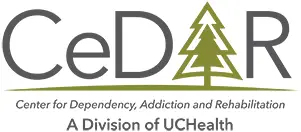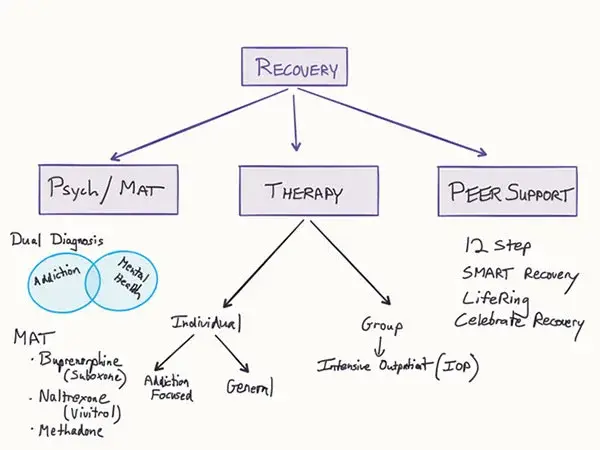ADDICTION SCIENCE
Listen to the audio version of this article:
Treatment planning is a large component of what an addiction clinician does with people entering rehab. This involves a blend of understanding a specific patient’s health needs, being attuned to the concept of ‘good fit’ with patients, and realizing feasibility of treatment options. Aligning these parts makes for a fundamentally sound plan that will likely have good engagement by the patient. Misaligning will lead to treatment dropout, poor clinical outcomes, and likely relapse.
To start with this topic, we need to discuss the available columns of clinical care available. The following diagram breaks it into 3 primary columns:
- Psych/Med-Assisted Treatment (MAT) – The meds listed in this diagram are specific for opioid addiction. Other meds such as Naltrexone, Antabuse or Gabapentin would be part of an alcoholism recovery plan.
- Therapy
- Peer Support
A recovery plan can involve any or all of these options, but it at least needs to involve something on this list. For different addictions, we may weigh certain columns as more powerful or evidence-based than others. For instance, opioid addiction responds very well to Medication-Assisted Treatment. In contrast, cocaine addiction responds poorly to medication approaches. Most of the studies looking at meds to prevent cocaine relapse or cravings have shown generally unimpressive outcomes.
Psychotherapy in Addiction Treatment
Psychotherapy in recovery is divided into individual and group therapy, with individual therapy being markedly more accessible. Intensive outpatient programs (IOPs) are the most common group modalities and these are often available through hospital centers or clinics. A typical IOP will run 3 times per week (for about 3 hours per session) for a total of 3 months. IOP constitutes Level 2 addiction treatment as compared to individual outpatient therapy which is Level 1 treatment.
Most people with active addiction issues should see a therapist with advanced training and expertise in treating addiction. These providers are very comfortable with the topic of addiction and recovery and are often aware of the current science used to treat this disease. They also are able to blend supportive and insight-oriented approaches with your recovery needs. It is possible to find a generalist therapist who could help you effectively in recovery, but there is some liability that you will be told very inaccurate things about addiction by some therapists.
Peer Support as a Valuable Ingredient
The role of Peer Support has overall evolved in addiction treatment. Residential treatment centers were almost exclusively staffed with members of 12-step programs, and now they tend to be very multidisciplinary. Referrals following rehab would usually consist of attending 90 meetings in 90 days. Today, there are numerous avenues of Peer Support available in addition to 12-step programs. Each can have a useful place for people seeking recovery.
Today, to use Peer Support programs such as Alcoholics Anonymous, Narcotic’s Anonymous or SMART Recovery, you need to do a base needs assessment. What would you be seeking in a self-help group? Examples could include a social connection to help with loneliness, a sense of identity in recovery, or some structural components in your day to fill dead time that is often wrought with triggers (and relapses). One of the strengths of these programs is that they are free, highly available, and demonstrate some of the fundamentally sound components of good therapy, especially when meeting with a sponsor. These include trust, avoiding judgments, and an emphasis on health.
The Bond of Fellowship
One of the most valuable things people receive from working a Peer Support program is that of fellowship. By creating bonds with other people seeking to find health, morale can increase and a sense of hope builds. If someone else was able to feel comfortable in sobriety, maybe you could too!
If you are using an MAT component in your recovery, there are some 12-step meetings that may be unwelcoming to you. This seems to be more the case with opioid-dependent people taking either Buprenorphine or Methadone medications in a maintenance fashion. The primary stance of 12-step programs is to encourage a good, thoughtful dialogue with your medical provider about available medication options. If you are experiencing too much input about meds through a 12-step meeting, consider seeking out a different group.
Build Something Appropriate for You
Above all, be mindful of how you feel about what you’re doing. Spending a large amount of time working a program that you resent doesn’t help anybody and we can do a lot better for you than ‘settling.’ Also, keep in mind, you need to do at least something dedicated to your recovery. If your motivation for recovery is adequate, you’ll find something that can work for you. For people who continually find reasons why all the available programs aren’t the right fit for them, it raises questions about their readiness to change.
A more sophisticated treatment center will offer multiple modalities of recovery for you to experience. People get to work with a combination of physicians, therapists, and Peer Support personnel. Through this kind of engagement, you are able to extend your recovery with the appropriate level of care. To ensure the effectiveness of treatment for long-term recovery, it all starts with building a solid treatment plan.

